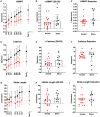Backward locomotor treadmill training combined with transcutaneous spinal direct current stimulation in stroke: a randomized pilot feasibility and safety study
- PMID: 32954299
- PMCID: PMC7425394
- DOI: 10.1093/braincomms/fcaa045
Backward locomotor treadmill training combined with transcutaneous spinal direct current stimulation in stroke: a randomized pilot feasibility and safety study
Abstract
Walking impairment impacts nearly 66% of stroke survivors and is a rising cause of morbidity worldwide. Despite conventional post-stroke rehabilitative care, the majority of stroke survivors experience continued limitations in their walking speed, temporospatial dynamics and walking capacity. Hence, novel and comprehensive approaches are needed to improve the trajectory of walking recovery in stroke survivors. Herein, we test the safety, feasibility and preliminary efficacy of two approaches for post-stroke walking recovery: backward locomotor treadmill training and transcutaneous spinal direct current stimulation. In this double-blinded study, 30 chronic stroke survivors (>6 months post-stroke) with mild-severe residual walking impairment underwent six 30-min sessions (three sessions/week) of backward locomotor treadmill training, with concurrent anodal (N = 19) or sham transcutaneous spinal direct current stimulation (N = 11) over the thoracolumbar spine, in a 2:1 stratified randomized fashion. The primary outcomes were: per cent participant completion, safety and tolerability of these two approaches. In addition, we collected data on training-related changes in overground walking speed, cadence, stride length (baseline, daily, 24-h post-intervention, 2 weeks post-intervention) and walking capacity (baseline, 24-h post-intervention, 2 weeks post-intervention), as secondary exploratory aims testing the preliminary efficacy of these interventions. Eighty-seven per cent (N = 26) of randomized participants completed the study protocol. The majority of the study attrition involved participants with severe baseline walking impairment. There were no serious adverse events in either the backward locomotor treadmill training or transcutaneous spinal direct current stimulation approaches. Also, both groups experienced a clinically meaningful improvement in walking speed immediately post-intervention that persisted at the 2-week follow-up. However, in contrast to our working hypothesis, anodal-transcutaneous spinal direct current stimulation did not enhance the degree of improvement in walking speed and capacity, relative to backward locomotor treadmill training + sham, in our sample. Backward locomotor treadmill training and transcutaneous spinal direct current stimulation are safe and feasible approaches for walking recovery in chronic stroke survivors. Definitive efficacy studies are needed to validate our findings on backward locomotor treadmill training-related changes in walking performance. The results raise interesting questions about mechanisms of locomotor learning in stroke, and well-powered transcutaneous spinal direct current stimulation dosing studies are needed to understand better its potential role as a neuromodulatory adjunct for walking rehabilitation.
Keywords: backward walking; gait; non-invasive spinal stimulation; post-stroke walking; stroke rehabilitation.
© The Author(s) (2020). Published by Oxford University Press on behalf of the Guarantors of Brain.
Figures





Similar articles
-
Exploring the Impact of Backward and Forward Locomotor Treadmill Training in Chronic Stroke Survivors with Severe Post-Stroke Walking Impairment: A Single-Center Pilot Randomized Controlled Trial.Brain Sci. 2025 Apr 24;15(5):437. doi: 10.3390/brainsci15050437. Brain Sci. 2025. PMID: 40426608 Free PMC article.
-
Characterizing the Longitudinal Impact of Backward Locomotor Treadmill Training on Walking and Balance Outcomes in Chronic Stroke Survivors: A Randomized Single Center Clinical Trial.medRxiv [Preprint]. 2024 Sep 13:2024.09.11.24313519. doi: 10.1101/2024.09.11.24313519. medRxiv. 2024. PMID: 39314955 Free PMC article. Preprint.
-
Transcutaneous spinal direct current stimulation improves locomotor learning in healthy humans.Brain Stimul. 2019 May-Jun;12(3):628-634. doi: 10.1016/j.brs.2019.01.017. Epub 2019 Jan 29. Brain Stimul. 2019. PMID: 30733143 Free PMC article. Clinical Trial.
-
Clinical Practice Guideline to Improve Locomotor Function Following Chronic Stroke, Incomplete Spinal Cord Injury, and Brain Injury.J Neurol Phys Ther. 2020 Jan;44(1):49-100. doi: 10.1097/NPT.0000000000000303. J Neurol Phys Ther. 2020. PMID: 31834165 Review.
-
Assessment of two gait training models: conventional physical therapy and treadmill exercise, in terms of their effectiveness after stroke.Hippokratia. 2018 Apr-Jun;22(2):51-59. Hippokratia. 2018. PMID: 31217676 Free PMC article. Review.
Cited by
-
Interventions to improve outdoor mobility among people living with disabilities: A systematic review.Campbell Syst Rev. 2024 Jun 14;20(2):e1407. doi: 10.1002/cl2.1407. eCollection 2024 Jun. Campbell Syst Rev. 2024. PMID: 38882933 Free PMC article. Review.
-
Serial Backward Locomotor Treadmill Training Improves Bidirectional Walking Performance in Chronic Stroke.Front Neurol. 2022 Mar 14;13:800757. doi: 10.3389/fneur.2022.800757. eCollection 2022. Front Neurol. 2022. PMID: 35359661 Free PMC article.
-
Feasibility of transcutaneous spinal direct current stimulation combined with locomotor training after spinal cord injury.Spinal Cord. 2022 Nov;60(11):971-977. doi: 10.1038/s41393-022-00801-1. Epub 2022 Apr 27. Spinal Cord. 2022. PMID: 35477745 Free PMC article.
-
What Else Can Be Done by the Spinal Cord? A Review on the Effectiveness of Transpinal Direct Current Stimulation (tsDCS) in Stroke Recovery.Int J Mol Sci. 2023 Jun 15;24(12):10173. doi: 10.3390/ijms241210173. Int J Mol Sci. 2023. PMID: 37373323 Free PMC article. Review.
-
Spinal Cord Stimulation for Poststroke Hemiparesis: A Scoping Review.Am J Occup Ther. 2024 Mar 1;78(2):7802180220. doi: 10.5014/ajot.2024.050533. Am J Occup Ther. 2024. PMID: 38477681 Free PMC article.
References
-
- Afzal M, Pyo S, Oh M-K, Park Y, Yoon J. Identifying the effects of using integrated haptic feedback for gait rehabilitation of stroke patients. 2017 International Conference on Rehabilitation Robotics (ICORR) 2017; 2017: 1055–60. - PubMed
-
- Antal A, Polania R, Schmidt-Samoa C, Dechent P, Paulus W.. Combining transcranial direct current stimulation with FMRI. Clin Neurophysiol 2010; 41: doi: 10.1055/s-0030-1250980. - PubMed
LinkOut - more resources
Full Text Sources
